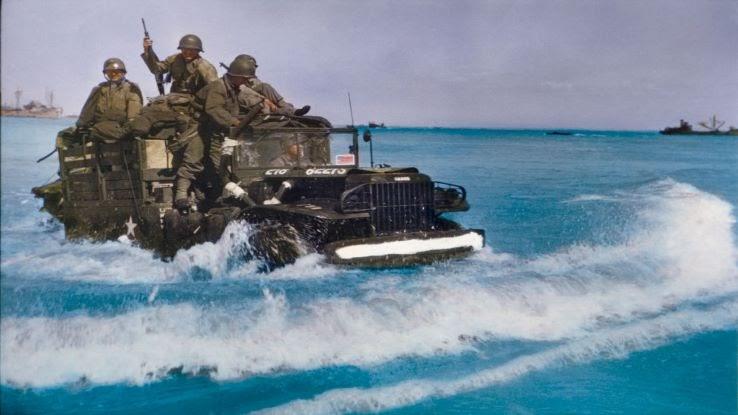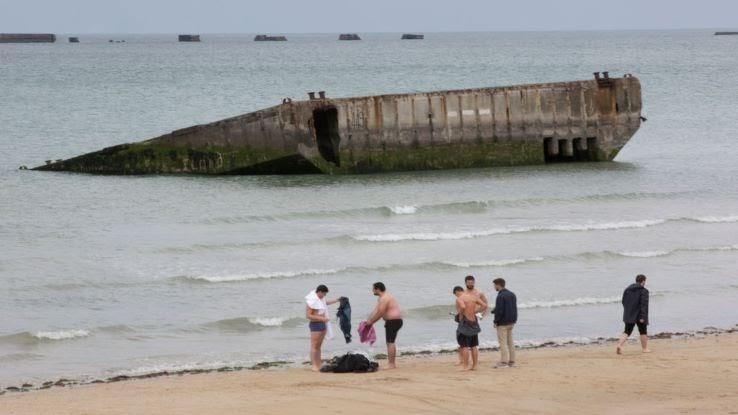Revive Us Again in the Key of D

On June half dozen, 1944, the Centrolineal powers launched D-Mean solar day, the largest seaborne invasion in history, and began the process of invading German-occupied Western Europe during World State of war II. Lawmaking-named "Operation Overlord," the invasion involved storming the beaches of Normandy, France.
The Normandy Invasion is oftentimes labeled as the beginning of the U.Southward.'southward interest in World State of war Two in the European theater, but a lot of work the U.South. did built up to that engagement. The U.Due south. took a neutral stance on Globe War Two until it became clear that neutrality was no longer an selection.
Today, Normandy is a pop holiday destination due largely to the historic legacy it holds. From its encarmine military by to the meaningful changes information technology symbolizes today, the Normandy Invasion remains a watershed moment that inverse the form of world history as we know information technology.
D-Day'due south History: Waiting for the U.S. to Make Its Move
To understand the assault and touring of Normandy beaches, it's important to have a look at what was going on in the world that led up to the historic day during a point in time after World War I when the political and social climates of the twenty-four hours led to the ballot of Adolf Hitler and the Holocaust.

While almost historians agree that the Holocaust started in 1941, the homo rights atrocities committed towards Jewish people had been happening long before. Jews were blamed for the failing economy in Germany later on the Great State of war, and Hitler spread propaganda about the Jewish people that helped him farther his political agenda.
When Hitler was elected in 1933, facism quickly spread, and it became increasingly brutal. The Concentration Military camp Dachau opened shortly after. The Nazi Party was granted unchecked legislative ability with The Enabling Act, which was passed in the aforementioned yr. Not long subsequently, Jewish people were intentionally isolated from guild. Their businesses were boycotted. They were forced to wear star-shaped badges that identified them as Jewish to the public. Homosexual, Black and Romani people were also isolated and oppressed.
It's difficult to look at the Holocaust's history and not wonder why the U.S. didn't go involved immediately. The United States has earned a reputation for being a law-similar effigy on the world'south stage. In the 1930s, nonetheless, the United States had just been a country for roughly 150 years and was yet in the process of developing the political, cultural and military might that it's at present known for.
Before the U.S. could sally as a victor in Earth State of war II, it needed justification for inbound as a combatant and overtly taking a side. On December 7, 1941, Pearl Harbor was attacked. This is the result that's typically credited with sparking the United states of america' involvement in World War II.
Prior to Pearl Harbor, the U.S. wanted to aid only did non want to be direct involved. The Lend-Lease Human action was passed in March 1941, several months prior to the attack on Pearl Harbor. Signed by President Roosevelt, this law sent more than $l billion in food and supplies — the equivalent of $225 billion today — to Allied nations like France, England and Communist china.
This still took identify a few years prior to the battle on Normandy Beach, France. D-Day and the Invasion of Normandy have a reputation for being the United States' famed archway into WWII combat, but the U.Due south. kept itself busy right later Pearl Harbor. Nigh Japan, U.S. troops saw battles in the Philippines, Solomon Islands and New Guinea, among other areas.
In Europe, the United States joined Allied forces by declaring war on Nazi Frg four days subsequently the Pearl Harbor set on and three days afterward declaring war on Japan. Europe saw more focus from the States because London and Moscow — the capital cities of two powerful Allies — were more readily attainable to Germany than whatever other Ally's position was to Japan. The United states of america Navy joined the Battle of the Atlantic not long after. The commencement battle on land fought by U.Due south. troops alongside other Allies was Operation Torch in N Africa. Sixteen million American troops would eventually serve during Earth State of war 2.
D-Twenty-four hours is less the beginning of U.South. interest in Earth State of war 2 and more the beginning of the finish of Earth War Ii itself.
What Happened During the Normandy Invasion Itself?
Normandy Embankment is located on the Northern Coast of French republic. The body of water that makes it a beach is not technically the Atlantic Body of water simply rather the English Channel, which spans 21 miles betwixt France and England. France's proximity to England made the state a priority to defend because England was such an important ally to the U.S.

Originally, the Pas de Calais, a segment of country partially bordering the channel, was considered a potential landing site for the invasion, being that it was the closest continental indicate to Great Uk. Due to this, the Germans fortified Pas de Calais more heavily against assail than other areas. However, the Centrolineal powers chose Normandy — which is near 200 miles southwest of Pas de Calais — as the landing site for the invasion considering the geographic point offered a broader front of attack, allowing simultaneous attacks of Cherbourg, diverse important coastal ports, and an overland push to Paris and then into Germany. It was also in closest range to fighter aircraft stationed in England.
The beaches that were stormed were divide into five sections: Utah, Omaha, Gold, Juno and Sword. Taking the beachheads cost the Allies considerable casualties, where approximately ten,000 men were lost, with four,414 confirmed dead. The landing crafts dropped soldiers into heavy car gun burn, where the Germans had ready up formidable defenses forth the coast. The beaches were laden with barbed wire, mines and other obstacles, making the invasion extremely deadly.
The invasion was originally scheduled for May 1, 1944. The date and then changed to June 5, simply inclement atmospheric condition pushed the commencement of the invasion to June half-dozen. D-Day is considered one of the virtually decisive moments of World War II. Many soldiers died that day, and today, the Normandy region contains numerous memorials, cemeteries and museums.
One factor in the operaton'due south success was deception. Instead of a Trojan Horse, Allied forces had Functioning Fortitude. This utilized imitation radio signals to throw the Germans off from the upcoming assault.
With about 160,000 troops crossing the channel that day and over 2 1000000 Centrolineal troops in all, the Normandy Invasion was more than one bloody day. This was the largest invasion that came past sea in known history. The boxing waged on for months, officially ending on Baronial xxx of 1944. During this time, the Allies besides engaged in gainsay from French republic's Southern waterfront and made their mode to Paris.
Touring Normandy Beaches: What the Onetime Battlefield Looks Like Today
While it's easy to envision Normandy Embankment as a somber area, it's become a pop tourist destination thanks to its dazzler but likewise due to the reflective mood information technology inspires. Tours from Paris to Normandy are not hard to observe — information technology's nigh a iii-hr drive from Paris.

Normandy has more than xi beaches where people can soak up some sun. Normandiac Cider is a popular beverage to try while exploring the area. There's too Le Mont-Saint-Michel, a medieval castle community situated off the declension that'southward only attainable when the tide drops low enough to reveal its underwater road.
Every five years, the area spares no expense in celebrating the Allies' victory and commemorating the lives lost in battle decades earlier. The event includes reenactments and parades, and it culminates in a fireworks display on Omaha embankment.
D-Day is an important day to call back because it marks neither a victory nor a defeat but a turning point that shifted the outcome of what remains the biggest and deadliest war in history. June half dozen, 1944, was the twenty-four hours the tides of World War Ii started to alter. Remembering the history of the Normandy Invasion is an acknowledgement of the bravery, selflessness and devotion of the Allied troops and of the strategy involved. Battles are long. Wars are even longer. Simply even when things are at their toughest, they can culminate in a way that shifts momentum for the ameliorate.
lewandowskiblever.blogspot.com
Source: https://www.reference.com/history/normandy-invasion-history?utm_content=params%3Ao%3D740005%26ad%3DdirN%26qo%3DserpIndex
0 Response to "Revive Us Again in the Key of D"
Post a Comment